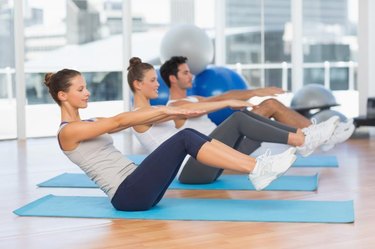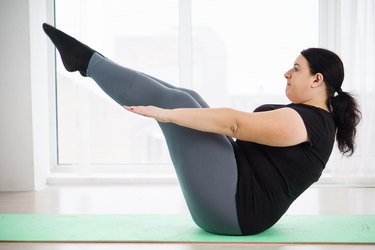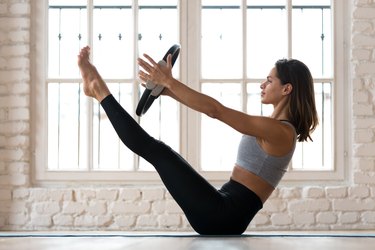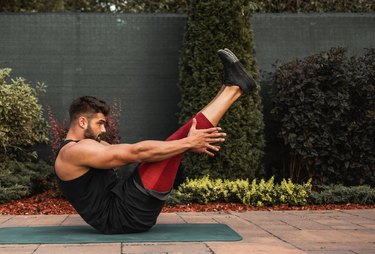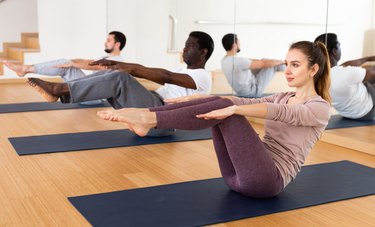
The hundred is a classic Pilates exercise that may sound intimidating, but it's actually a great move to add to your exercise routine. It gets its name from the way you pump your arms for a count of 100 while you hold the position.
In addition to core strengthening, it also works your arms and legs — and it takes less than 2 minutes to perform.
Video of the Day
Read on to learn more about how to do the Pilates hundred, muscles worked, benefits, form tips and variations.
- What is the Pilates hundred? This is a classic Pilates move in which you lie on a mat (or reformer), extend your legs and arms and lift your shoulders and head up. While in this position, you pump your arms for a count of 100, inhaling for a count of five and exhaling for a count of five.
- What is the Pilates hundred good for? The Pilates hundred is an exercise to warm up and engage your entire body, find your breathing pattern and oxygenate the blood, according to Allie Guillerm Tichenor, certified Pilates instructor and owner of Pilates Punx in Los Angeles.
- What muscles does the Pilates hundred work? "While people most often think of the hundred as an abdominal exercise, when done properly, you should be engaging the abdominals, the lats, the glutes, the inner thighs and the pelvic floor," Tichenor says.
- Who can do the Pilates hundred? This exercise is safe for most people, but listen to your body and stop if you feel pain. Avoid this move if you are pregnant (the crunching motion can cause diastasis recti, where your ab muscles separate). "If you have any neck injuries, shoulder injuries or hip issues, be careful with this exercise and modify as needed," says Christie Wang, certified Pilates instructor and studio owner of Ascend Pilates in San Diego. "Additionally, if you can't perform spinal flexion safely, avoid lifting your head in this exercise."
- Why is this move done at the beginning of a Pilates workout? This exercise is typically done at the beginning of a Pilates workout to help increase your heart rate and blood circulation, warm up your entire abdominal wall and body and wake up your lungs, according to Wang.
How to Do the Hundred With Proper Form
The key to maximizing the benefits of this move is to do it with proper form. Even though this move is usually done at the beginning of a mat Pilates class (or right after footwork for reformer Pilates, Tichenor says), it can be done any time you want a full-body exercise. Doing this move on a mat or other cushioned surface is recommended for max comfort.
The Pilates Hundred
- Lie down on your back on the floor or on an exercise mat with your arms straight down by your sides. Press your lower back down into the ground.
- Lift your feet off the ground so your legs are bent and tucked in toward your chest.
- Contract your core to lift your shoulders and head off the floor a few inches and extend your legs straight up. Keep your chin slightly tucked in.
- Lift your arms up and straight along your sides with your palms facing down.
- Inhale and pump your arms 5 times, then exhale and pump them 5 times. This makes a count of 10. Inhale through your nose and exhale through your mouth.
- Continue this pumping motion (5 pumps on an inhale and 5 pumps on an exhale) for 10 more sets to perform 100 pumps total.
The Benefits of the Pilates Hundred
The hundred exercise doesn't take long to perform (less than 2 minutes!), requires little equipment and can be done anywhere. It also has other benefits including:
1. Strengthening Your Entire Abdominal Wall
This exercise helps strengthen the entire abdominal wall, including the deepest corset muscles like the transversus abdominis, Wang says. A November 2008 study in The Archives of Physical Medicine and Rehabilitation found that the hundred strengthened both the transverse abdominals and the obliques. (A quick note that a lot of the research done in this area is a bit older.) Performing the hundred on the reformer machine (if you have access to one) will activate those muscles even more.
"This exercise also helps improve core stability while the arms pump vigorously by your sides. The entire body must work to stabilize against the pumping arms," Wang says.
A strong core helps prevent back pain, according to the Cleveland Clinic, because if the muscles around your midsection are weak, "your body will rely more on passive structures for stability, including ligaments — the tissue that connects bone to bone — as well as the spinal bones or discs which lie between the spinal bones. This can cause pain."
2. Working Muscles in Your Whole Body
In addition to your core, the pumping motion works your shoulders and arms. Even though your core is working to hold your legs up, your hip flexors, inner thighs and glutes will also be working hard during this move.
3. Improving Your Breathing
With this move, you breathe in through your nose and out through your mouth, alternating every five seconds. "We encourage nasal breathing in the hundred, which taps into your body's natural filtration system," Wang says.
Breathing through your nose can filter out foreign particles before they hit your lungs and humidify inhaled air to keep your airways from getting dried out, per the Allergy and Asthma Network.
4. Increasing Your Heart Rate
Vigorously pumping your arms helps increase your heart rate and improve circulation, according to Wang.
Keep in mind that although this move does help improve circulation and increase heart rate for a good warmup, it probably won't increase your heart rate enough to be counted as cardiovascular exercise, a November 2005 study from the American Council of Exercise (ACE) points out. To improve your cardiovascular health, you should also incorporate higher-intensity exercises — such as brisk walking, running or cycling — into your weekly exercise routine.
Common Mistakes (and How to Fix Them)
1. You Lift From Your Neck
One of the most common mistakes Tichenor sees is "not lifting the chest high enough or trying to just lift from the neck, placing tension in the neck." Focus on lifting both your shoulders and neck off of the ground. If you have neck pain while doing this move, you can perform it with your head and shoulders on the mat, however, it won't strengthen your core as quickly as with your neck and shoulders raised.
2. You Point Your Chin Up
Try to avoid pointing your chin up to the ceiling, as this can place too much stress on your neck. Keep your chin tucked slightly — or keep a fist-width distance between your chin and chest.
3. You Pump Your Arms at an Uneven Cadence
Tichenor says she often sees people pumping their arms too slowly or too quickly. Make sure you're pumping your arms steadily and at the same rate as you're counting. Make sure your arms stay straight and focus on moving from the base of your shoulders, not bending at your wrists or elbows, she advises.
4. You Don't Engage Your Core
While performing this move, it's important you brace your core muscles the entire time. Wang says to avoid "pressing the stomach out and away," and instead focus on "in and up."
5. Your Legs Are Too High or Too Low
Make sure you keep your legs slightly lower than a straight-up position. "Lowering the legs too far down allows the low back to strain," Tichenor says. On the other hand, raising your legs too high doesn't engage your core muscles enough.
If you're having difficulty maintaining proper form and keeping your core engaged with your leg position, you can also place them in a tabletop position (see the video below geared toward beginners) until your core muscles get stronger. You can make this move more difficult by lowering your legs down further (see the video below geared toward advanced exercisers).
Variations of the Pilates Hundred
There are several ways you can modify the hundred exercise, depending on if you want to make it easier or more difficult. Tichenor demonstrates three variations of the hundred below.
1. The Hundred in Tabletop Position (Beginner)
If you're having difficulty keeping your core muscles contracted with your legs raised, keeping your legs in a tabletop position is a good modification.
- Lie down on your back on the floor or on an exercise mat with your arms straight down by your sides. Press your lower back down into the ground.
- Lift your feet off the ground so your legs are bent and tucked in toward your chest.
- Lower your feet down so your legs are bent at a 90-degree angle in a tabletop position.
- Contract your core to lift your shoulders and head off the floor a few inches. Keep your chin slightly tucked in.
- Lift your arms up and straight along your sides with your palms facing down.
- Inhale and pump your arms 5 times, then exhale and pump them 5 times. This makes a count of 10. Inhale through your nose and exhale through your mouth.
- Continue this pumping motion (5 pumps on an inhale and 5 pumps on an exhale) for 10 more sets to perform 100 pumps total.
2. The Hundred With Legs at 45-Degree Angle (Advanced)
To make the hundred even more difficult, lower your legs down to a 45-degree angle to make your core muscles work harder.
- Lie down on your back on the floor or on an exercise mat with your arms straight down by your sides. Press your lower back down into the ground.
- Lift your feet off the ground so your legs are bent and tucked in toward your chest.
- Lower your feet down and straighten your legs so they're at a 45-degree angle.
- Contract your core to lift your shoulders and head off the floor a few inches. Keep your chin slightly tucked in.
- Lift your arms up and straight along your sides with your palms facing down.
- Inhale and pump your arms 5 times, then exhale and pump them 5 times. This makes a count of 10. Inhale through your nose and exhale through your mouth.
- Continue this pumping motion (5 pumps on an inhale and 5 pumps on an exhale) for 10 more sets to perform 100 pumps total.
3. The Hundred With Ball Between Legs (Advanced)
If you're ready to further challenge yourself, use a Pilates ring or ball to really feel the burn in your inner thighs. A July 2021 study in The Journal of Bodywork and Movement Therapies found that performing this move while squeezing the Pilates ring (or a ball) actually increases core muscle activation as well.
- Lie down on your back on the floor or on an exercise mat with your arms straight down by your sides. Press your lower back down into the ground.
- Place a Pilates ring or ball between your legs, above your knee joint. Squeeze the Pilates ring or ball between your thighs.
- Lift your feet off the ground so your legs are bent and tucked in toward your chest.
- Contract your core to lift your shoulders and head off the floor a few inches and extend your legs straight up. Keep your chin slightly tucked in.
- Lift your arms up and straight along your sides with your palms facing down.
- Inhale and pump your arms 5 times, then exhale and pump them 5 times. This makes a count of 10. Inhale through your nose and exhale through your mouth. Continue squeezing the Pilates ring or ball between your thighs.
- Continue this pumping motion (5 pumps on an inhale and 5 pumps on an exhale) for 10 more sets to perform 100 pumps total.
How to Add the Pilates Hundred to Your Workouts
The hundred exercise is a great move to add to your Pilates routine, preferably at the beginning of your routine to get your body warmed up and primed for the upcoming moves. You can also use this exercise as a stand-alone move to strengthen your core to help prevent back pain.
In general, you can add Pilates to your exercise routine at least two to three times per week. You should also include higher-intensity exercises for cardiovascular conditioning. If you want to build up muscle mass, however, you should incorporate lifting heavy weights several times a week because Pilates isn't the best exercise modality to help you reach this goal.
- The Archives of Physical Medicine and Rehabilitation: "Transversus Abdominis and Obliquus Internus Activity During Pilates Exercises: Measurement With Ultrasound Scanning"
- Cleveland Clinic: "Why a Strong Core Can Help Reduce Low Back Pain"
- American Council on Exercise: "Can Pilates Do It All?"
- The Journal of Bodywork and Movement Therapies: "Comparative Analysis of Core Muscle Activation According to the Use of Props and the Different Knee Angle During the Modified Pilates Hundred"
- Allergy and Asthma Network: "Your Nose: The Ultimate Air Cleaner"
